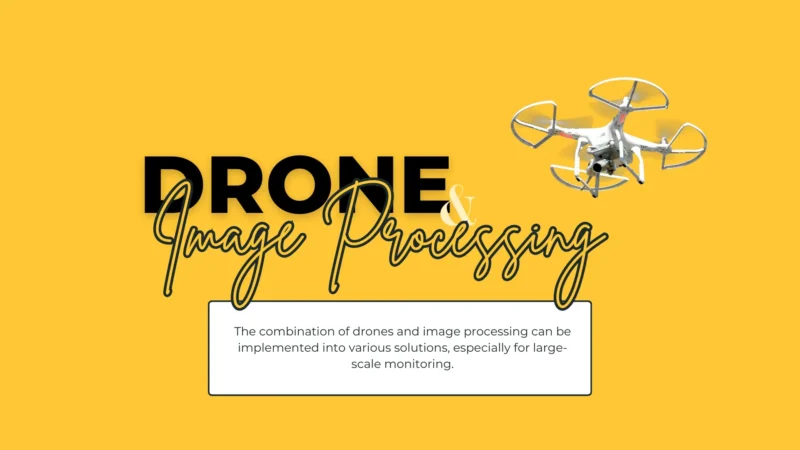Greetings, fellow Nawala! May you always be in good health.
This is the IAES Nawala of the Institute of Advanced Engineering and Science. Today we will bring you news about the role of drones in image processing. The combination of drones and image processing can be implemented into various solutions, especially large-scale monitoring. Alsafasfeh et al. (2022) proposed a new method by combining drones and image processing for real-time monitoring of the condition of solar power generator systems. This method uses two types of cameras mounted on drones, namely thermal cameras and charge-coupling (CCD) cameras. The research also tested parallel processing to reduce the processing time of the inspection system and showed better acceleration results. In this study, they used the multiprocessing module in Python to run the error detection algorithm on the frames (generated by both cameras). The experimental results showed an efficient decrease in execution time, with an average of 3.1 times using 2 processes and 6.3 times using 4 processes. It is concluded that parallel processing can significantly reduce the execution time and improve the performance of real-time condition monitoring of solar power plant systems.
Super-linear speedup for real-time condition monitoring using image processing and drones
Moath Alsafasfeh, Bradely Bazuin, Ikhlas Abdel-Qader
Real-time inspections for the large-scale solar system may take a long time to get the hazard situations for any failures that may take place in the solar panels normal operations, where prior hazards detection is important. Reducing the execution time and improving the system’s performance are the ultimate goals of multiprocessing or multicore systems. Real-time video processing and analysis from two camcorders, thermal and charge-coupling devices (CCD), mounted on a drone compose the embedded system being proposed for solar panels inspection. The inspection method needs more time for capturing and processing the frames and detecting the faulty panels. The system can determine the longitude and latitude of the defect position information in real-time. In this work, we investigate parallel processing for the image processing operations which reduces the processing time for the inspection systems. The results show a super-linear speedup for real-time condition monitoring in large-scale solar systems. Using the multiprocessing module in Python, we execute fault detection algorithms using streamed frames from both video cameras. The experimental results show a super-linear speedup for thermal and CCD video processing, the execution time is efficiently reduced with an average of 3.1 times and 6.3 times using 2 processes and 4 processes respectively.
Norahim et al. (2023) used drones in image processing to reconstruct 3D models of accident locations. They analyzed various flight parameters and methods for data gathering. The results of this study include a 3D model of the accident site, an orthophoto map, and an accuracy assessment of the reconstructed 3D model. To evaluate the accuracy of the 3D model, researchers used the root mean square error (RMSE) value. The best method that produces the smallest RMSE is to use the circular method with 5-meter ground control. These results show that drones can replace field measurements in reconstructing accident sites. The conclusions obtained show that the use of drones in image processing can have a significant impact on accident investigation and traffic congestion.
Reconstructing 3D model of accident scene using drone image processing
Mohamad Norsyafiq Iman Norahim, Khairul Nizam Tahar, Gyanu Raja Maharjan, Jose C. Matos
At the current stage, an investigation technique on the accident takes a longer time and this causes longer traffic congestion. The aim of this study is to reconstruct a 3D model of an accident scene using an unmanned aerial vehicle (UAV). The flight parameters that have been chosen are the circular method, the double grid method, and the single grid method. All these designs can produce a good 3D model to achieve the study’s objective. The methodology in this study is divided into 4 phases which are preliminary work, data acquisition, data processing, and data analysis. The main results of this study are the 3D model of the accident scene, an orthophoto map layout, and an accuracy assessment of a 3D model of reconstructed accident scene. All these parameters will be tested on accuracy based on the root mean square error (RMSE) value, comparing the UAV data and site measurement data. This objective has been tested for 10 different types of processing and different types of flight parameters. The best result among all the methods is the circular method 5 meters with ground control point (GCP) since this method has the least RMSE value which is 0.047 m. UAVs can replace the site measurement to reconstruct the accident scene.
The above articles are just a small part of the research on the role of drones in image processing. To get more information, readers can visit the International Journal of Electrical and Computer Engineering (IJECE) page and read articles for FREE through the following links: https://ijece.iaescore.com/.
By: I. Busthomi

